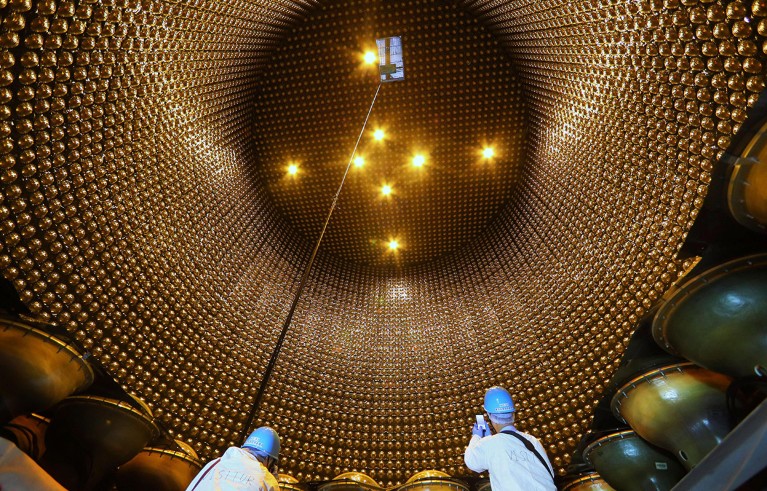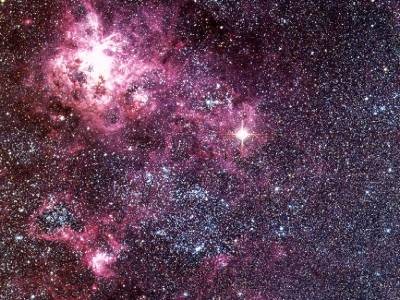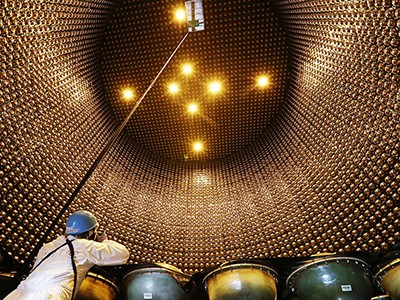
Super-Kamiokande’s underground tank must be drained for major maintenance work.Credit: Takumi Harada/Yomiuri Shimbun via AP/Alamy
Every few seconds, somewhere in the observable Universe, a massive star collapses and unleashes a supernova explosion. Japan’s Super-Kamiokande observatory might now be collecting a steady trickle of neutrinos from those cataclysms, physicists say — amounting to a few detections a year.
These tiny subatomic particles are central to understanding what goes on inside a supernova: because they zip out of the star’s collapsing core and across space, they can provide information about any potentially new physics that occur under extreme conditions.
At last month’s Neutrino 2024 conference in Milan, Italy, Masayuki Harada, a physicist at the University of Tokyo, revealed that the first hints of supernova neutrinos seem to be emerging from the cacophony of particles that the Super-Kamiokande detector collects every day from other sources, such as cosmic rays hitting the atmosphere and nuclear fusion in the Sun’s core. The result “indicates that we started observing a signal”, says Masayuki Nakahata, a physicist at the University of Tokyo and spokesperson for the experiment, which is commonly referred to as Super-K. But Nakahata cautions that the supporting data — collected over 956 days of observation — are still very weak.
Elusive particles
Neutrinos are extremely hard to catch. Most travel through the planet like light through glass, and Super-K catches only a tiny fraction of those that cross it. Even so, the detector has a decent chance of catching neutrinos from supernovae, because the Universe should be awash with them. The collapse of a star releases stupendous numbers of these particles (estimated to be around 1058), producing what astrophysicists call the diffuse supernova neutrino background.
A supernova could light up the Milky Way at any time. Astronomers will be watching
But as yet, no one has been able to detect this background. Neutrinos have only once been conclusively traced back to a collapsing star — Nakahata was among the researchers who spotted the particles using the Kamiokande-II detector, a predecessor of Super-K, in 1987. The detection was possible because the supernova had occurred in the Large Magellanic Cloud, a dwarf galaxy that is close enough that the exploding star’s neutrinos reached Earth in large numbers.
In 2018–20, the Super-K detector, a tank containing 50,000 tonnes of purified water located under one kilometre of rock near Hida in central Honshu Island, underwent a simple but important upgrade aimed at increasing its ability to tell supernova neutrinos apart from other particles.
When a neutrino — or more precisely, its antiparticle, an antineutrino — collides with a proton in the water, that proton can transform into a pair of other particles, a neutron and an antielectron. The antielectron produces a flash of light as it travels at high speed in the water, and that light is captured by the sensors that line the tank’s walls. By itself, that flash of light could be indistinguishable from those produced by neutrinos or antineutrinos from a number of other sources.
But during the upgrade, scientists added a gadolinium-based salt to Super-K’s water. This allows the neutron produced when an antineutrino hits the water to be captured by the gadolinium nucleus, which releases a second, telltale flash of energy. Super-K physicists in search of supernova neutrinos look for a rapid sequence of two flashes, one produced by the antielectron and the second by the neutron being captured.
Solving cosmic mysteries
It will still take several years for genuine supernova signals to clearly emerge, Nakahata says, because double-flash signals can come from other neutrino sources, including those generated by cosmic rays hitting the atmosphere. But by the time Super-K is scheduled to shut down in 2029, he adds, it should have gathered enough data to make a solid claim.
And an even larger experiment called Hyper-Kamiokande, scheduled to be completed around 2027, could massively improve on Super-K’s results. Initially, Hyper-K will be filled with pure water, but “all components of the detector are tested to be compatible with gadolinium”, which could be added at a later time, says Francesca Di Lodovico, a physicist at King’s College London and co-spokesperson for the project.
Gigantic Japanese detector prepares to catch neutrinos from supernovae
Showing that neutrinos from distant supernovae that happened billions of years ago are still around would confirm that neutrinos are stable particles and do not decay into something else, says Nakahata. This is something physicists have long suspected but haven’t been able to prove decisively.
Measuring the full spectrum of supernova neutrino energies could also provide clues about how many supernovae have gone off during different epochs of cosmic history, says Harada. In addition, it could reveal how many collapsing stars resulted in a black hole — which would halt the emission of neutrinos — as opposed to leaving behind a neutron star.
The data from Super-K are still too weak to claim a discovery, but the prospect of detecting the diffuse neutrinos is “extremely exciting”, says Ignacio Taboada, a physicist at the Georgia Institute of Technology in Atlanta and spokesperson for the IceCube neutrino observatory at the South Pole. “Neutrinos would provide an independent measurement on the history of star formation in the Universe.”


